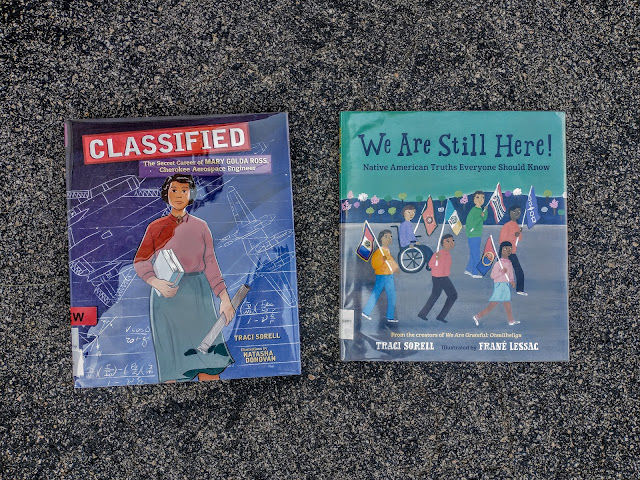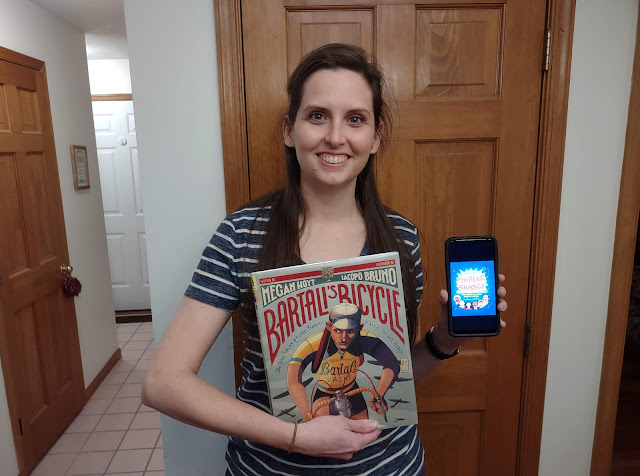I'm so excited to announce the winners of the Cybils award for Elementary & Middle Grade Nonfiction!
This year I served as a Round Two judge on the Elementary & Middle Grade Nonfiction panel for the Cybils - Children's and Young Adult Bloggers Literary Awards. The awards have been going for 16 years now, and I have been volunteering
in some capacity for the last 14 years -- wow!
I have to say that I felt like
the entire shortlist for the Elementary Nonfiction category was really strong. As I told my fellow panelists, I wouldn't be sad if
any of these books won. I'll be reviewing each of them in the coming weeks. The Middle Grade Nonfiction category had many strong contenders, too!
Books earn the Cybils award by being exemplary in two areas: Kid Appeal and Literary Merit. We discuss and award books on these two criteria. Do kids like the book? And is the book good, from a literary standpoint?
Round one judges read all the nominated books published in the past year (October of the year prior through October of the present year) and evaluate them on Kid Appeal and Literary Merit. They narrow this list (maybe 150 books or more) down to 5-7 titles. This is the shortlist.
Round two judges narrow the shortlist in each category down to the single winner! And that's what we have here for you today. The BEST nonfiction book for kids ages 5-8 in the Elementary nonfiction category, and the best nonfiction book for kids ages 8-12 in the Middle Grade category.
written by Megan Hoyt illustrated by Iacopo Bruno
This is a picture book biography of Gino Bartali that is so beautiful and inspiring!
As one of my fellow panelists pointed out, riding a bike is something kids can relate to in a big way, and that's what Gino Bartali was famous for . . . at least at first. When it came to cycling, he trained persistently and eventually won the Tour de France! But when Nazis invaded Italy, Gino became another kind of hero. He used his cycling skills to protect and preserve the lives of those around him. And the humility he exhibited throughout his life and despite his achievements is memorialized here.
In deciding between Bartali's Bicycle and some of our other strong contenders, panelists talked about the gorgeous, dynamic illustrations of Iacopo Bruno. Guys, I know "we don't talk about Bruno," but this art is top notch! Each page conveys movement and has an interesting, fresh layout.
Materials at the end of the book include a letter to readers from Gino Bartali's granddaughter, a timeline, and a full page of sources.
Definitely give this book a read. As soon as I finished it, I thought I had better share it with the most avid cyclist that I know. I'm sure you'll find someone to share it with, too. When looking at a picture book, you have to consider, is an adult going to want to read this over and over? Is a kid going to want to read it? Bartali's Bicycle will definitely appeal to ages 5+ and stand up to repeated reading.
by Rochelle Melander, illustrated by Melina Ontiveros
Mightier than the Sword was a little bit tricky for some of us judges to get our hands on! It was published by a small press, and so it wasn't available in my library. However, if your library has hoopla (kind of like the Netflix of ebooks and music for libraries?), then you can find this title there. And it is absolutely worth finding!
If I'm totally honest, I wasn't particularly looking forward to reading a bunch of bios of writers. It is really easy for this type of book to become same-samey. Maybe you turn to it for one person, but you'll never read it cover to cover. WRONG! I absolutely read Mightier than the Sword from cover to cover and it was not even a chore. It was delightful!
For one thing, the writing is engaging and fantastic. (Thank goodness! To have sub-par writing in a book about so many writers would be embarrassing.) Each person's story is brought to life with interesting details and relevant quotes. And then, if that wasn't enough, there are little sidebars or cameos of other relevant writers in each chapter. The organization of the book made it really interesting to me, as well. Each chapter is a writer's biography and they are ordered by year of the writer's birth. So, the book as a whole becomes something of a history book, as you go along.
I'm reading
A Little History of the World by E.H. Gombrich with my daughter Jubilee right now -- we're just taking a chapter at a time on nights when we can squeeze it in. It's great. But honestly, I can't wait to read
Mightier than the Sword with her! She is going to eat it up. Especially because she has some aspirations to writing, and each chapter ends with writing prompts and suggestions.
Another engaging facet of the book is the illustrations. Each writer and each sidebar gets a portrait by Melina Ontiveros. For the names I didn't already recognize, it was fun to try to puzzle out who this person would be based on the small items included in their portrait.
As a group, we round two judges loved that it was a diverse group of writers highlighted. Not only were writers from a variety of homelands and races, but also diverse through time, as I've mentioned, and they are diversely famous -- some of them are famous for being writers (Shakespeare is profiled), but others are more famous for other work they've done (Florence Nightingale, for instance). And still others of them weren't already known to me. Mightier than the Sword made learning a pleasure.
One of my fellow panelists was formerly a teacher and she was very excited about the potential for classrooms to use this book. It would be very easy to read excerpts, and of course the suggested writing activities would connect to teachers and students well, too.
I hope winning the Cybils award for Middle Grade Nonfiction shines some more light on this book, because it deserves to be found!
A full list of this year's Cybils winners in all categories can be found
here.














